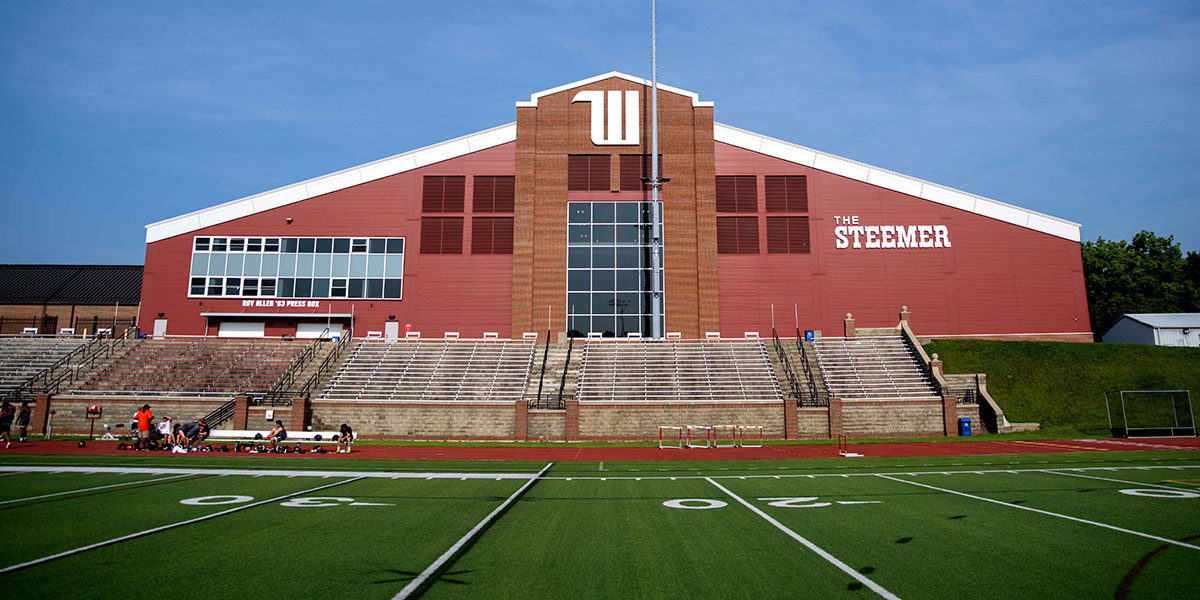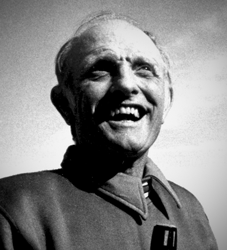Edwards-Maurer Field

Edwards-Maurer Field, home to Tiger field hockey, football, men's and women's lacrosse, and men's and women's soccer.
About This Facility
Set adjacent to the Health, Wellness & Athletics (HWA) Complex and encircled by Earl F. Morris Track on the north end of Wittenberg's picturesque 100-acre campus, Edwards-Maurer Field serves as the competition home of the Tiger field hockey, football, men's and women's lacrosse, and men's and women's soccer teams. Situated within historic Wittenberg Stadium, Edwards-Maurer Field also hosts outdoor club and intramurals events, in addition to a variety of high school and youth activities throughout the year.
In 2005, the field's knitted nylon artificial surface was replaced with Prestige artificial turf, and a new UBU Sports Speed Series S5-M synthetic turf was laid in 2015. The playing surface is designed to handle year-round, multi-sport use and unpredictable Ohio weather, with the 2015 turf installed by Maumee Bay Turf Center.
The turf upgrade to Edwards-Maurer Field in 2005 coincided with the resurfacing of Earl F. Morris Track with a Recotan surface (work performed by DeFargo Sports Surfaces of Round Rock, Texas), the opening of the Rosencrans Hall of Honor Fitness Center and the reconstruction of the staircase leading to the main entrance of the stadium. The men's and women's soccer teams began competing at the field after the installation of the turf, having previously played at Bill Edwards Field, near Betty Doughman Dillahunt Field.
Edwards-Maurer Field stands on a site which has served as the home of Tiger football since 1923, field hockey since 1993, lacrosse since 1968 and soccer since 2005. In 1993, the $2.2 million Bill Edwards Drive Project installed Astroturf, lights (for the first time since 1967) and a new track. On Sept. 8, 1993, a ribbon-cutting ceremony preceded the first intercollegiate game on the new surface, which saw field hockey host Earlham and also served as a celebration of the 100th anniversary of women's athletics at Wittenberg. The dedication of Edwards-Maurer Field occured on Oct. 2, 1993, at halftime of the Homecoming football game vs. Case Western Reserve.
The field has played host to countless Ohio Athletic Conference and North Coast Athletic Conference championships, NCAA Division III postseason games, and regular season thrillers over the years. Even on chilly November nights and wet March afternoons, the Tiger faithful pack the stands.
![]() Accessibility: Edwards-Maurer Field and Wittenberg Stadium are fully accessible to individuals with disabilities, and the Athletics staff is happy to make accommodations for interested patrons. The stadium features wheelchair seating at the top of the stands, and both the north and south gates are accessible via wheelchair.
Accessibility: Edwards-Maurer Field and Wittenberg Stadium are fully accessible to individuals with disabilities, and the Athletics staff is happy to make accommodations for interested patrons. The stadium features wheelchair seating at the top of the stands, and both the north and south gates are accessible via wheelchair.
 Bill Edwards
Bill Edwards
Bill Edwards, Wittenberg class of 1931, was introduced as the university's athletic director and head football coach on April 3, 1955. The Wittenberg University Department of Athletics hasn’t been the same since, rising to a level of prominence in small college athletics that is rivaled by few of its peers.
Edwards, who had high school, college and professional coaching experience before taking a pay cut to return to his alma mater, patrolled the sidelines for three national titles in the 1960s while compiling a 98-20-4 record in 14 years as Wittenberg's head football coach (1955-69). He was later inducted into the National College Football Hall of Fame, one of four Wittenberg athletes or coaches to gain such acclaim, and he was a member of the inaugural class of the university's Athletics Hall of Honor in 1985. He passed away in 1987.
Find more information on his legacy at Wittenberg in this news release, commemorating the 50th anniversary of his hiring.
 Dave Maurer
Dave Maurer
Dave Maurer built a tremendous legacy over 40 years as a coach, administrator and professor. Maurer, a 1987 Wittenberg Athletics Hall of Honor inductee, coached track and field, swimming and diving, and golf at various points during his Wittenberg career, in addition to his well-known exploits on the football sidelines. He also served as the university's director of men's athletics and was a professor of health and physical education. Maurer passed away in 2011 at the age of 79.
After more than a decade as an assistant football coach at Wittenberg, Maurer took the reins in 1969. Through 1983, Maurer posted a career record of 129-23-3, good for an astounding .842 winning percentage, best among active coaches at that time, and he earned national coach of the year honors twice. Along the way, Maurer directed three teams to national championships (and was an assistant coach for two other national titlists) and two teams to NCAA Division III Tournament runner-up finishes. The Tigers went undefeated three times and won seven Ohio Athletic Conference championships in his 15 seasons as head coach, and Maurer was later inducted into the National College Football Hall of Fame.
Find more information on his lasting impact at Wittenberg in this online feature, celebrating "Dave Maurer Day" at Wittenberg.
History

The original Wittenberg Stadium (pictured left: Zimmerman Field circa 1915) was constructed over 1922 and 1923, and dedicated on Saturday, Oct. 20, of that year, prior to a 14-0 loss to visiting Ohio Wesleyan. Capacity crowds of 5,000 in both the permanent west stands and equally large but temporary east stands, where both student sections were seated, plus standing room only crowds of more than 2,000 set the attendance record of over 12,000. The facility was constructed with concrete stands seating 4,980, at a cost of $100,000. At the time, the Springfield Daily News described the stadium as the second largest college football stadium in Ohio, behind only Ohio Stadium in Columbus, which opened the year before in 1922.
Wittenberg Stadium was built on an abandoned gravel pit directly east of Zimmerman Field, which had served as the school's athletic field since 1902. College President Rees Edgar Tulloss selected the site, and Athletics Director and College Football Hall of Famer Ernie Godfrey and his assistants prepared the playing field. Work on the field included digging out 10,000 cubic yards of earth and replacing it with two feet of conditioned gravel topped by soil and sod at an appropriate slope. Original plans called for the completion of a bowl-type stadium seating 30,000 spectators. Work to secure financing and acquire land began in 1919.
Zimmerman Field had been the first permanent enclosed athletic field at the college before it was succeeded by Wittenberg Stadium. A group of local business leaders led by John L. Zimmerman purchased the land in 1902 and donated it to the school in Zimmerman's name. The first game played at the new field was a scoreless tie with Kenyon on November 27, 1902, the last game of the season.
In 1910, the field was enlarged, enclosed with a fence and given a cinder track. At the same time, a wooden grandstand was built, although it was once destroyed by fire and rebuilt. Zimmerman Field played host to the football and track & field teams through 1922 when they moved to the stadium. The Old Gym, originally located behind Recitation Hall, was moved next to Zimmerman Field in 1902 and replaced by the Field House in 1929. Zimmerman Field's record attendance of more than 4,000 came during a 12-10 win over Denison on Nov. 11, 1905. Pam Evans Smith Arena and other HPER Center facilities currently occupy most of the original site, though a portion remains in use as a practice field for various teams.
 Pictured right: Wittenberg Stadium circa 1975
Pictured right: Wittenberg Stadium circa 1975
After football and track moved to the new stadium, baseball continued to play at Zimmerman Field until they began using Springfield's Municipal Stadium in 1981. The softball team called Zimmerman Field home through 1981, and in 1982 moved to their current location at Betty Doughman Dillahunt Field. The teams found other homes in anticipation of the construction of the HPER Center on the site, which was completed in 1983. Men's and women's lacrosse have played on Edwards-Maurer Field since their inceptions as varsity teams in 1968 and 1972, respectively, although weather occasionally forced them back to Zimmerman Field until the arrival of artificial turf. Lacrosse practices were sometimes held in Cliff Park, now known as Veterans Park.
 Pictured left: Wittenberg fans cheering at Edwards-Maurer Field (circa 2009)
Pictured left: Wittenberg fans cheering at Edwards-Maurer Field (circa 2009)
Men's and women's soccer moved to Edwards-Maurer Field in 2005 with the installation of a new turf system. Prior to 2005, the teams played at Bill Edwards Field, next to softball's Dillahunt Field. The field was the first permanent home for both soccer teams after years of playing in Snyder Park and several other locations throughout Springfield.
Prior to the addition of Zimmerman Field in 1902, Wittenberg athletic teams played at various locations throughout the city of Springfield. From 1892 to 1896, games were conducted on a field at the YMCA, located at Mason St. and Stanton Ave., across N. Limestone St. from campus, now a residential area. Teams were also known to utilize the old baseball grounds on the west end of the city near the Springfield Malleable Iron Works. From 1900 to 1902 activities came back to an open field behind the campus, with occasional games taking place at Champion park in Lagonda.
John Strawn '07
Some information from Springfield Daily News and Springfield Sun
Quick Facts |
|
| Seating Capacity: | 3,000 |
| Surface: | Artificial (Speed Series S5-M, 2015) |
| Built: | 1922-23 |
| Renovated: | 1993 |
| Dedicated: | |
| as Edwards-Maurer Field: | Oct. 2, 1993 |
| as Wittenberg Stadium: | Oct. 20, 1923 |
| First Game: | Oct. 6, 1923 (Football), W, 79-6 vs. Antioch |
| Record Attendance: | 12,274 - Oct. 20, 1923 (Football) L, 0-14 vs. Ohio Wesleyan |
|
Parking • Directions • Tickets • Seating |
|